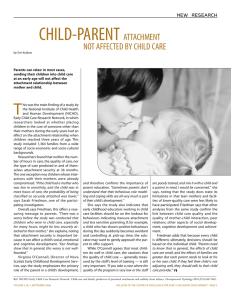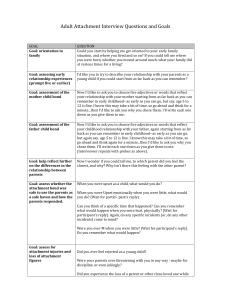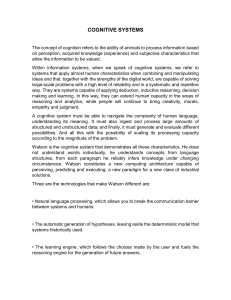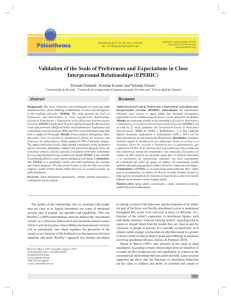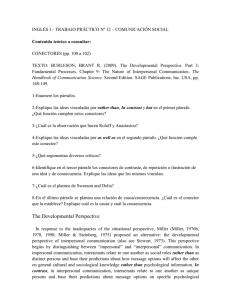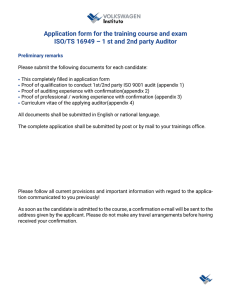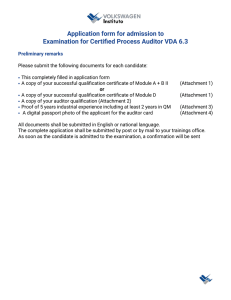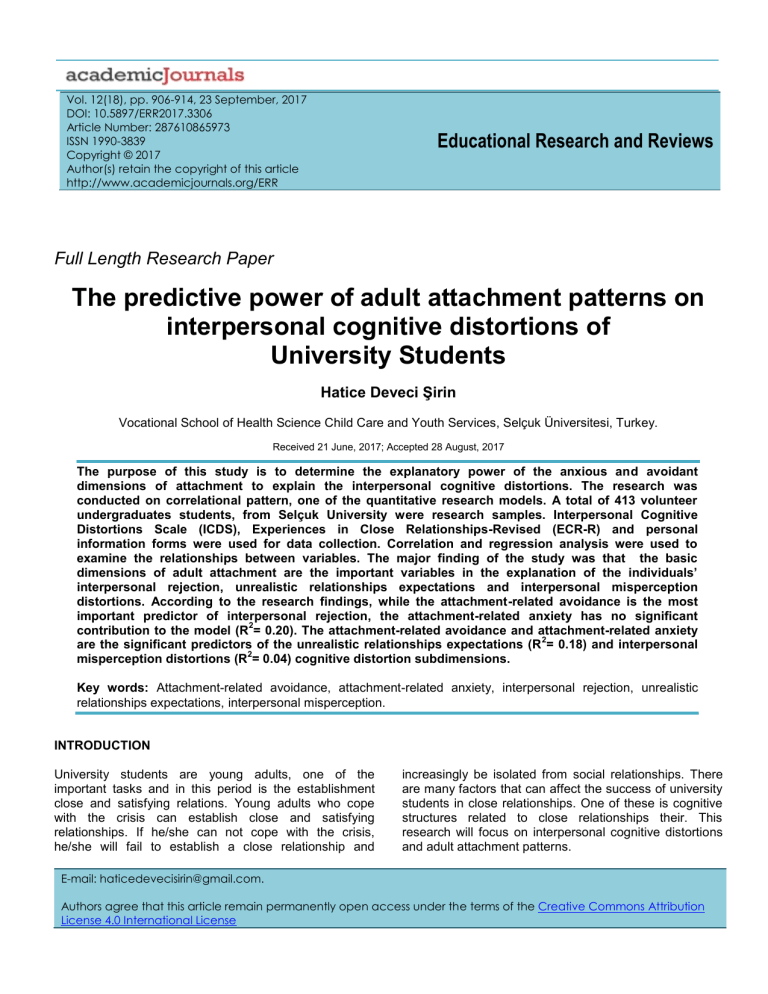
Vol. 12(18), pp. 906-914, 23 September, 2017 DOI: 10.5897/ERR2017.3306 Article Number: 287610865973 ISSN 1990-3839 Copyright © 2017 Author(s) retain the copyright of this article http://www.academicjournals.org/ERR Educational Research and Reviews Full Length Research Paper The predictive power of adult attachment patterns on interpersonal cognitive distortions of University Students Hatice Deveci Şirin Vocational School of Health Science Child Care and Youth Services, Selçuk Üniversitesi, Turkey. Received 21 June, 2017; Accepted 28 August, 2017 The purpose of this study is to determine the explanatory power of the anxious and avoidant dimensions of attachment to explain the interpersonal cognitive distortions. The research was conducted on correlational pattern, one of the quantitative research models. A total of 413 volunteer undergraduates students, from Selçuk University were research samples. Interpersonal Cognitive Distortions Scale (ICDS), Experiences in Close Relationships-Revised (ECR-R) and personal information forms were used for data collection. Correlation and regression analysis were used to examine the relationships between variables. The major finding of the study was that the basic dimensions of adult attachment are the important variables in the explanation of the individuals’ interpersonal rejection, unrealistic relationships expectations and interpersonal misperception distortions. According to the research findings, while the attachment-related avoidance is the most important predictor of interpersonal rejection, the attachment-related anxiety has no significant 2 contribution to the model (R = 0.20). The attachment-related avoidance and attachment-related anxiety 2 are the significant predictors of the unrealistic relationships expectations (R = 0.18) and interpersonal 2 misperception distortions (R = 0.04) cognitive distortion subdimensions. Key words: Attachment-related avoidance, attachment-related anxiety, interpersonal rejection, unrealistic relationships expectations, interpersonal misperception. INTRODUCTION University students are young adults, one of the important tasks and in this period is the establishment close and satisfying relations. Young adults who cope with the crisis can establish close and satisfying relationships. If he/she can not cope with the crisis, he/she will fail to establish a close relationship and increasingly be isolated from social relationships. There are many factors that can affect the success of university students in close relationships. One of these is cognitive structures related to close relationships their. This research will focus on interpersonal cognitive distortions and adult attachment patterns. E-mail: haticedevecisirin@gmail.com. Authors agree that this article remain permanently open access under the terms of the Creative Commons Attribution License 4.0 International License Şirin Cognitive structures lie at the roots of the attachment behaviour that cannot be observed in social life. The roots of the attachment system is in the cognitive structures which are the internal working models that are formed as a result of an individual’s interaction with the world. In this context, it is accepted that attachment system is also a cognitive system. Cognitive system consists of interconnected layers such as schema, basic beliefs, cognitive distortions and automatic thoughts. These layers underlying the behaviour become activated as ther are connected and occur in sequence. The focus of this study is to understand the relationship between cognitive distortions and the dimensions of attachment. Adult attachment Human beings are equipped with a large number of systems. Every system has a different function but serves a common goal. This common goal can be articulated as “survival”. Of these systems, the attachment system has increasingly been the focus of attention in recent years in an effort to explain the emotions and cognitions that underlie human behaviours. Though many researchers have contributed to the evolution of attachment theory, it was broadly outlined by John Bowlby (1907-1990). The attachment theory has its origins in etiology, psychodynamic and cognitive approach. In theoretical explanations made by Bowlby (2012), it was postulated that attachment behaviour includes instinctive and cognitive processes and it was emphasized: “Instinctive behaviour (e.g., attachment behaviour) becomes activated when external stimuli stimulate the central nervous system; however the behaviour is based on the chain connections between the emotional inputs, not on the intensity of the external stimuli.” Bowlby observed that children need safety and security as well as shelter and feeding (Van Ijzendoorn, 2001), and found that there are severe distortions in the relationships child criminals build with their mothers during early childhood (Stevenson-Hinde and Hinde, 2001). Bowlby (1952) argues that separation or loss of mother in early childhood has negative effects on the development of individuals. Physical, cognitive, emotional and social areas are also affected by these negative effects throughout life. According to attachment theory, the quality of the relationship with the attachment figure in early childhood and adolescence affects one’s perception of security. Internal representations called internal working models/mental models that individuals develop to understand the world, self and other significant people 907 (Collins, 1996) occur in the early years of life. Mental models formed in early childhood are the relationship schemas that represent an individual’s attempts to gain security and comfort (Main et al., 1985). These cognitive structures could be regarded as the cognitive aspect of attachment system. How responsive and sensitive the attachment figure is to the signals an individual shows when seeking security becomes the determinant of secure or insecure attachment by forming the internal working models. The individual expects three main types of support from the attachment figure, which are proximity, safe haven and secure base. Proximity is the comfort provided by the attachment figure by fulfilling the psychological and physiological needs of an individual, and anxiety, protest and separation might be observed in the absence of the attachment figure (Bowlby, 2012). The support called safe haven is described as the instrumental and emotional support offered by the attachment figure when an individual feels anxious and is presented with obstacles (Mikulincer and Shaver, 2009). Secure base is the support provided by the attachment figure for an individual to explore the world around, grow up and develop (Reizer and Mikulincer, 2007; Ainsworth et al., 2015). The individual attaches securely when these three types of support are provided by the attachment figure. Individuals with secure attachment have positive views for themselves and for other people, they love others and have a sense of being loved (Deniz, 2011). Securitybased strategies appear in the presence of the attachment figure (Mikulincer et al., 2003). Securely attached individuals use these strategies to seek support from the attachment figure when they feel helpless in coping with stress as well as to access their internal resources whenever they need in their adulthood. On the other hand, individuals with insecure attachment have no sense of security. Anxiety and avoidance – two main dimensions of insecure attachment-develop as a result of negative interactions with the attachment figure (Atkinson et al., 2000). Anxious individuals are worried that they are not loved, will be left and rejected by those important in their lives, and avoidant individuals have difficulty developing intimacy and close relationships with other people (Collins and Feeney, 2004; Hazan and Shaver, 1994; Hazan and Shaver, 1987). It is known that both anxious and avoidant individuals are not able to maintain positive relationships with the attachment figure. If the attachment figure is not present or unresponsive during stress and anxiety, it then means the primary attachment strategies have become unsuccessful. One continues to fight stress and anxiety and develops alternative strategies - secondary attachment strategies to cope with the distress (Main, 1990, 1996; Mikulincer and Shaver, 2009). Secondary attachment strategies are described with two strategies that correspond with the dimensions of anxiety and avoidance. The first one, 908 Educ. Res. Rev. hyperactivating strategies, corresponds with the dimension of anxiety and the second one, deactivating strategies refers to avoidance (Mikulincer and Shaver, 2005; Hazan and Shaver, 1987; Mikulincer et al., 2004). Hyperactivating strategies are associated with being extremely vigilant, remaining highly sensitive and being too preoccupied with the threatening situation until the security is sensed. Cognitive distortions about relationships According to cognitive theory, cognitive structure is examined under two main topics; schemas and automatic thoughts. Schemas are divided into two categories as intermediate beliefs and core beliefs. Under the broader definition of cognitive structure, automatic thoughts are on the surface and they are followed by intermediate beliefs with core beliefs in the centre or core (Türkçapar, 2013). In order to understand the nature of cognitive distortions, it is essential to understand the relationships of these structures with each other and with distortions. Automatic thoughts are the ones that appear in telegraphic form and spontaneously occur and flow through one's mind. They are compelling, resistant and difficult-to-control (Beck, 2002; Türkçapar, 2013). They show how individuals construct their worlds and are considered to be the output of the information processing system (Calvete and Connor-Smith, 2005). Intermediate beliefs are described with assumptions and rules, Intermediate beliefs are the body of constant expectations and rules that individuals develop for themselves and for the attitudes of other people. They are rigid and imperative and connected with depression, anger and worry (Türkçapar, 2013; Leahy, 2010). As to core beliefs, they are the cognitive structures that take form based on one’s past experiences, involve selfschemas and determine how an individual processes internal and environmental information (Beck et al., 1979; Dozois and Beck, 2008; Türkçapar, 2013). Individuals have boyth dysfunctional as well as functional beliefs. This leads to certain cognitive biases and errors during information process that distinctive cognitive structure of every individual puts to work (Türkçapar, 2013). These thought errors are called cognitive distortions. Many psychological problems such as depression, anxiety and anger arise from recurring patterns of cognitive distortions. Mind reading and catastrophizing are considered to be among the cognitive distortions observed in individuals (Leahy, 2010). The focus of this study is on the cognitive distortions related to relationships. Cognitive distortions connected with relationships are classified as avoidance of proximity, unrealistic relationship expectations and interpersonal misperception. Interpersonal rejection creates negative expectations about other people and includes thoughts that establishing close relationships with others causes negative effects. Unrealistic relationship expectation is described as holding high expectations of self and others and their attitudes (Hamamcı and Büyüköztürk, 2003). Interpersonal misperception involves thought errors that you know what others think and how they feel about you (Hamamcı and Büyüköztürk, 2003; Leahy, 2010). As stated theoretically, it is believed that cognitive structures that are dysfunctional and specific to individuals lie behind these cognitive distortions. Cognitive distortions that affect interpersonal relationships feed on erroneous data that are recorded in the schemas in early childhood years and they become activated when faced with challenging life circumstances (Weary and Edwards, 1994). Cognitive distortions are connected with the way individuals are raised as well as their belief system (Leung and Poon, 2001). Moreover, the attachment system which affects the entire life of individuals also takes form in early childhood years. The attachment behaviours exhibited by individuals are based on internal working models/mental models that are formed by their past experiences (Simpson and Rholes, 2017). Internal working models or mental models that form the basis of adult attachment are in fact the schemas relating to others. Negative, inconsistent early life experiences are likely to bring about depressive schemas (Dozois and Beck, 2008). For that reason, internal working models are thought to be a cognitive scaffold for the adult core beliefs/basic beliefs about self and others (Ingram, 2003). In the light of these considerations, there is a need to clarify the connection between the factors related to cognitive structure and the main dimensions of attachment. Yet, these variables have been examined by only a small number of studies. Previous studies on adult attachment and cognitive structure have investigated the relationship between attachment and cognitive vulnerability in depression (Ingram, 2003), cognitive and affective components of empathy (Britton and Fuendeling, 2005), social perception (Collins, 1996), early childhood memories (Cunha et al., 2013), cognitive jealousy (Curun and Çapkın, 2014), prejudices in social information processing (Davis et al., 2014), adjustment factors (Drake, 2014; Gudjonsson et al., 2008), negative life experiences and adjustment factors (Drake et al., 2011), cognitive flexibility (Gündüz, 2013) and decision-making styles and five-factor personality traits (Deniz, 2011). No studies have been carried out to specifically investigate the connection between the dimensions of attachment in close relationships and the cognitive distortions about relationships. It is however, reported that the effects of attachment experiences in early life continue into adulthood (Hazan and Shaver, 1987), the differences in adult attachment result from the experiences existing in interpersonal schemas and these schemas are created together with early attachment styles (Berscheid, 1994). It Şirin seems that revealing the link between the dimensions of adult attachment and the cognitive distortions of relationships, which are an extent of cognitive structure, will contribute to the studies focussing on both cognitive structures and adult attachment. It will also provide a fresh perspective into the effect of regulation in adults. In light of this information, the purpose of the present study is to reveal the relationship between the two main dimensions of attachment – anxiety and avoidance – and the cognitive distortions of interpersonal rejection, unrealistic relationship expectations and interpersonal misperception. Aligned with this main aim, the following hypotheses were tested: Hypothesis 1. Attachment-related anxiety and avoidance with a joint effect significantly predict the interpersonal rejection. Hypothesis 2. Anxiety and avoidance with a joint effect significantly predict unrealistic relationship expectations. Hypothesis 3. Anxiety and avoidance with a joint effect significantly predict interpersonal misperception. MATERIALS AND METHODS Study sample A total of 413 voluntary undergraduate students – 300 female and 113 male – from Selçuk University were randomly selected as sample of the study. Majority of them were students of the Faculty of Literature and Vocational School of Health Services, while the others were from the Faculty of Sport Sciences, Faculty of Sciences, Faculty of Fine Arts and Faculty of Communication. 909 Experiences in close relationships-revised (ECR-R) The scale was developed to measure the attachment in adults (Fraley et al., 2000). The scale consisted of two subscales with 36 items. These factors constitute two dimensions, “anxiety” and “avoidance”, each consisting of 18 items. 7-point Likert-type scale ranging from 1 (I strongly disagree) to 7 (I strongly agree) was used. There was reverse scoring items (4., 8., 16., 17., 18., 20., 21., 22., 24., 26., 30., 32., 34 and 36.) The score on each dimension ranged from 18 to 126; the higher the score, the greater the avoidant attachment and the attachment anxiety. Cronbach’s alpha coefficient was found to be 0.90 for “avoidance” and 0.96 for “anxiety”. To test the reliability of the scale, test-retest reliability method was used and the reliability coefficients were found to be 0.81 and 0.82 for “avoidance” and “anxiety” respectively (Selçuk et al., 2005). The Cronbach’s alpha internal consistency coefficient calculated for this study was 0.96. Personal data form Developed by the researcher, this form was used to collect data on demographic variables of participants such as gender, faculty/department and year of study. Research data was collected by the researcher on a volunteer basis between April and August 2015 at the Aladdin Keykubat Campus of Selcuk University in Turkey. In the analysis of the data, standard deviations and mean scores were calculated to present information about the data set, and Person’s correlation coefficient was calculated to measure the direction and the strength of the relationship between variables. Multiple Linear Regression analysis was conducted in order to determine the predictive power of independent variables (attachment related anxiety and avoidance) on the dependent variables (interpersonal rejection, unrealistic relationship expectations and interpersonal misperception). RESULTS AND DISCUSSION Data collection ınstruments and analysis Results of correlation analysis Interpersonal cognitive distortions scale Pearson’s correlation coefficients were calculated to observe the correlation of dependent and independent variables in the study. Results of correlation analysis are given in Table 1. Table 1 presents the mean scores and standard deviations for interpersonal rejection (X=20.3; Sd=5.2), unrealistic relationship expectations (X=24.3; Sd=5.7), interpersonal misperception (X=9.5; Sd= 2.4), attachment-related anxiety (X=68.1; Sd=18) and avoidance (X=59; Sd=17.5). According to the given data, the highest mean scores were observed in unrealistic relationship expectations among cognitive distortions and in the anxiety dimension of attachment. Analysis of the correlation between variables revealed that interpersonal rejection had a moderate linear relationship with anxiety (r= 0.45; p<0.01) and a low linear relationship with avoidance (r= 0.16; p<0.01). Also, it was found that unrealistic relationship expectations had a significant moderate linear relationship with anxiety (r= 0.40; p<0.01), yet no significant relationship was observed with avoidance. Finally, a significant low positive linear relationship was found between interpersonal Developed by Hamamcı and Büyüköztürk (2004), the purpose of the scale is to evaluate the cognitive distortions exhibited by individuals in their interpersonal relationships. Interpersonal Cognitive Distortions Scale (ICDS), was developed to measure dysfunctional beliefs related to interpersonal relationships. The scale consisted of three subscales with 19 items; Interpersonal Rejection (8 items), Unrealistic Relationship Expectation (8 items) and Interpersonal Misperception (3 items). 5-point Likert-type scale ranging from 1 (I strongly disagree) to 5 (I strongly agree) was used. There were no reverse scoring items. Scores ranged from 19 to 95. To examine construct validity, the correlations between ICDS and other scale was estimated. The correlation between that scale and Automatic Thoughts Scale was 0.54, and the correlation between the ICDS and the Conflict Tendency Scale 0.53 were estimated. The minimum score on the scale was 19 and the maximum score was 95. A high score on the scale is an indication of cognitive distortions in relationships. Regarding the validity and reliability of the scale, the Cronbach’s alpha internal consistency coefficient for the complete scale was 0.67. Considering subscales, it was calculated to be 0.73 for interpersonal rejection, 0.66 for Unrealistic Relationship Expectations and 0.49 for Interpersonal Misperception (Hamamcı and Büyüköztürk, 2004). The Cronbach’s alpha coefficient calculated for the present study was 0.78. 910 Educ. Res. Rev. Table 1. Results of the Bivariate Correlations between Dependent and Independent Variables. S/N Variables 1 2 3 4 5 Interpersonal rejection Unrealistic relationship expectations Interpersonal misperception Anxiety Avoidance 20.3 24.3 9.5 68.1 59 Sd 1 2 3 4 5 5.2 5.7 2.4 18 17.5 1 ** .28 ** .20 ** .45 ** .16 1 ** .26 ** .40 -.05 1 ** .15 -.10 1 ** .27 1 *p< 0.05; **p< 0.01. misperception and anxiety (r= 0.15; p<0.01) while there was no significant relationship between interpersonal misperception and avoidance. opposite effects on the dependent variable. The regression equation for the model is as follows; Interpersonal Misperception =9.00+ (-0.02) × Anxiety + 0.03 × Avoidance. Therefore, Hypothesis 3 was also supported. Results of regression analysis In order to find out to what extent the attachment-related anxiety and avoidance explained the dependent variables of interpersonal rejection, unrealistic relationship expectations and interpersonal misperception, a multiple linear regression analysis was carried out and the results were presented in Table 2. According to the findings in Hypothesis 1, it is seen that the independent variables entered into the model significantly predicted the dependent variable of the 2 interpersonal rejection (R= 0.45, R = 0.20, F(2, 410) = 51.73, p< 0.05). With a joint effect, anxiety and avoidance explained 20% of the total variance in avoidance of proximity. On the other hand, anxiety alone had no significant effect on the scores from the interpersonal rejection. The regression equation for the model is as follows; Interpersonal Rejection =10.99 +0.01 × Anxiety+0.13 × Avoidance. Hypothesis 1 was supported. The findings relating to Hypothesis 2 showed that the independent variables entered into the model significantly predicted unrealistic relationship expectations (R= 0.43, 2 R = 0.18, F(2, 410) = 45.89, p< 0.05). Joint effect of anxiety and avoidance explained 18% of the variance in unrealistic relationship expectations. The effect size of the independent variables indicated that both variables had significant and opposite effects on the dependent variable. The regression equation for the model is as follows; Unrealistic Relationship Expectation =18.13+(0.06) × Anxiety +0.14 × Avoidance accordingly, Hypothesis 2 was supported. Findings related to Hypothesis 3 showed that independent variables significantly predicted the dependent variable of interpersonal misperception (R= 2 0.21, R = 0.04, F(2, 410) = 9.06, p< 0.05). Anxiety and avoidance with a joint effect explained 4% of the total variance. The effect size of the independent variables demonstrated that both variables had significant and DISCUSSION Findings regarding Hypothesis 1 indicated that anxiety scores accounted for the interpersonal rejection through the joint effect of avoidance scores, and the dimension of avoidance alone had a significant effect on the cognitive distortion of interpersonal rejection. Individuals with interpersonal rejection develop negative expectations of other people and avoid being in close relationship with them believing that maintaining close relationship with others will lead to negative consequences (Hamamcı and Büyüköztürk, 2003). Recent research on interpersonal rejection has shown that it is one of the problems that arise from internet use which encourages isolation is related to having difficulties with building social relationships with others (Kalkan, 2012). Moreover, high scores on interpersonal rejection were found to be connected with high level of isolation (Kılınç and Sevim, 2005), tendency towards aggression, depression and anxiety (Leung and Poon, 2001) and impulsiveness (Mobini et al., 2006). That is, individuals who suffer from the cognitive distortion of interpersonal rejection avoid establishing close relationships with those around them. The case is similar with the avoidant attachment. Individuals with avoidant attachment overrate themselves and avoid having close connections by developing negative expectations of others (Griffin and Bartholomew, 1994). This way, they minimize the risk of getting emotionally hurt. Here the positive-self and negativeother is the predominant model. These internal models influence the relationships they hold with the individuals close to them. It is likely that avoidant individuals learn to avoid because they had hurtful and offending past experiences. Avoidance includes negative expectations with respect to reliance on other people (Baldwin et al., Şirin 1996). Research findings show that the higher the attachment avoidance scores are, the lower the emphatic concern felt towards the partner is (Britton and Fuendeling, 2005), those who have high avoidance scores also have high alexithymia scores (Batıgün and Büyükşahin, 2008) and women with higher avoidance scores exhibit less support-seeking and support-giving behaviors in a stressful situation when compared to those with lower avoidance scores. It is also seen that they dislike physical contact during interaction with their partner and children (Chopik et al., 2014; Selcuk et al., 2010), are more likely to engage in infidelity and desire to meet alternative partners (DeWall et al. 2011), display lower levels of social skills (Deniz et al., 2005) and inhibit interpersonal relationships (Eraslan, 2009). As evidenced by this study, the interpersonal rejection accounted for the avoidance scores, which is consistent with the literature findings. It was found that attachment avoidance had a significant impact on interpersonal rejection while anxiety alone had no such effect. This is because individuals with attachment avoidance tend to avoid establishing relationships with others whereas anxiously attached ones do the opposite, although the dimensions of anxiety and avoidance are both insecurity. Anxiously attached individuals tend to exaggerate the presence and seriousness of threats and choose to pay attention to the signs of negative emotions (Shaver and Mikulincer, 2007). Whether they feel positive and secure about themselves depends on if they are accepted or not Erözkan (2011). In close relationships, they are obsessively attached and very jealous (Hazan and Shaver, 1987). For that reason, anxiety scores are thought to have no significant effect on the interpersonal rejection scores. Findings related to Hypothesis 2 revealed that anxiety has a negative while avoidance has positive significant effect on unrealistic relationship expectations. It might be suggested that the dimensions of attachment have opposite effects on unrealistic relationship expectations. Unrealistic relationship expectations is described as having high standards and expectations of oneself and others. Hamamcı and Büyüköztürk (2003). A study investigating the relationship between the dimensions of attachment and unrealistic belief found that insecurely attached individuals have more unrealistic beliefs in their romantic relationships than securely attached ones (Stackert and Bursik, 2003). In this sense, the finding that dimensions of insecure attachment account for the unrealistic relationship expectations seems to be consistent with previous research. It was seen that attachment anxiety scores had a negative effect on unrealistic relationship expectations. There is yet no study that relates the dimensions of adult attachment and this cognitive distortion. On the other hand, there are studies that investigate the effect of 911 anxiety on close relationships. For instance, it has been found that avoidant attachment has a negative effect on relationship beliefs about proximity that covers codes such as willingness to please other people (Drake, 2014), communication, agreement, love, trust, respect and loyalty (Fletcher and Kininmonth, 1992). Existing studies do not provide enough data to interpret this finding. It is therefore suggested that unrealistic relationship expectations need to be studied with different variables related to close relationship. Another finding concerning Hypothesis 2 was that the dimension of avoidance had a positive significant effect on unrealistic relationship expectations. Attachment avoidance is associated with having distant and rejecting attitudes. Avoidant people learn the behaviour of avoidance as their attempts to seek proximity remain unanswered all the time. In fact, what they need and therefore seek is the same as what they avoid. Attachment figure is rejected but his or her proximity is still desired (Ainsworth et al., 2015). For that reason, avoidant individuals act in a rejecting manner even when they desire proximity and security, because their intention is to maintain independency, autonomy and control in their relationship so as not be hurt (Mikulincer, 1998). An avoidant person might be testing others for the desired feelings of proximity and security by deliberating pushing them away and setting high standards of expectation Previous studies reported that avoidant personality act more defensively and furiously under stress (Rholes et al., 1999), but their avoidant behaviours tend to disappear when adequate support is provided (Girme et al., 2015). It is believed that the stress caused by these internal conditions provoke avoidant individuals to build up realistic expectations about their relationships. Findings related to Hypothesis 3 indicated that both anxiety and avoidance alone and with a joint effect had a significant effect on the dependent variable. These two variables affected the dependent variable in opposite ways (Table 2). Proceeding on theoretical explanations will make it easier to interpret and understand this finding. According to Bowlby (2012), a behavior emerging as a result of an activation caused by a behavioral system (here, it is the observation of attachment behaviors as a result of the activation of attachment system) could be compatible, incompatible or somewhat compatible with a behavior caused by another system activation (for the present study, it is the cognitive distortion of interpersonal misperception which occurs as a result of the activation of cognitive system). In this case, a wide variety of consequences might arise. Behavioral contingencies could be as follows; both behavioral patterns may be exhibited, only one may be exhibited or neither of them may be exhibited. Keeping this in mind, it is noteworthy that seeking security and secondary strategies are connected with this topic, as evidenced in recent studies. 912 Educ. Res. Rev. Table 2. Results of the multiple regression analysis regarding the predictive power of the ındependent variables on dimensions of cognitive distortions. Predicted Variable Interpersonal rejection Predicting variable B Standard deviation (Fixed) 10.99 1.06 Anxious Attachment 0.01 0.01 Avoidant Attachment 0.13 0.01 2 Multiple R= 0.45 R =0.20 2 Adj R = 0.20 F (2, 410) = 51.73, p=0.00< 0.05 β 0.05 0.44 t 10.35 0.97 9.50 p 0.00 0.33 0.00 Unrealistic relationship expectations (Fixed) 18.13 Anxious Attachment -0.06 Avoidant Attachment 0.14 2 Multiple R= 0.43 R =0.18 2 Adj R = 0.18 F (2, 410) = 45.89, p=0.00< 0.05 1.17 0.02 0.02 -0.17 0.44 15.45 -3.69 9.51 0.00 0.00 0.00 Interpersonal misperception (Fixed) 9.00 Anxious Attachment -0.02 Avoidant Attachment 0.03 2 Multiple R= 0.21 R =0.04 2 Adj R =0.04 F (2, 410) = 9.06, p=0.00< 0.05 0.53 0.01 0.01 -0.15 0.19 17.11 -2.92 3.77 0.00 0.00 0.00 *p< 0.05. The dimension of anxiety is approached as hyperactivating strategies and the dimension of avoidance as deactivating strategies (Mikulincer and Shaver 2005; Hazan and Shaver, 1987). An anxiously attached individual who uses hyperactivating strategies reacts at a high level of stimulation when getting organized to increase proximity in order to regain the sense of security. In this case, the presence or accessibility of the attachment figure could be perceived as more vital than what the attachment figure is thinking. This way, the use of hyperactivating strategies might have overshadowed and negatively affected the cognitive distortion of interpersonal misperception. On the other hand, avoidant deactivating strategies are attempts of suppression to keep the attachment system deactivated to avoid further distress in the event that the attachment figure is inaccessible (Mikulincer et al., 2003; Hazan and Shaver, 1987; Çalışır, 2009). This way, it is likely that the attachment system that overshadows the cognitive distortion of interpersonal misperception has become deactivated and a positive relationship might have been observed between attachment avoidance and interpersonal misperception. In brief, attachment system and cognitive system are likely to be stimulated by internal and external stimuli at the same time. In this case, emotional inputs related to the stimulus overactivate the attachment system for the dimension of anxiety while they passivize the cognitive system which serves to feed into the cognitive distortion of interpersonal misperception. On the other side, the same stimulus might be passivizing the attachment system while it overactivates the cognitive system for the dimension of avoidance. This study involves certain limitations in terms of study population, theoretical framework and measurement tools. Study population was made up of unmarried young adults. The results therefore can only be generalized to similar samples. The dependent variables in the study were limited to cognitive distortions of “Interpersonal Rejection”, “Unrealistic Relationship Expectations” and “Interpersonal Misperception”. Attachment orientation was measured dimensionally. No categorical measures were performed. Inventory-type tests were used to measure adult attachment. CONCLUSION AND RECOMMENDATIONS The results of the study show that attachment anxiety and avoidance are important predictors of the cognitive distortions in relationships. Avoidance alone significantly accounts for all of the cognitive distortions in relationships (interpersonal rejection, unrealistic relationship expectations and interpersonal misperception). Anxiety alone can explain the cognitive distortions of unrealistic relationship expectations and interpersonal misperception, whereas it cannot significantly explain the interpersonal rejection. Further research can investigate the relationships between adult attachment patterns and core beliefs, Şirin intermediate beliefs and automatic thoughts. Using diverse research methods, the multidimensional exploration of the relationship between cognitive schemas and internal working models will especially make significant contributions to the literature. Based on the study results, it is suggested that the psychological counselors who serve the university students include the attachment history of university students into the therapeutic process and take it as a reference when working with their cognitive structures. CONFLICT OF INTERESTS The author has not declared any conflict of interests. ACKNOWLEDGMENTS This paper was presented as an oral presentation at the III. International Eurasian Educational Research Congress-EJER 2016 under the title of “Investigation of the Predictive Power of Attachment Patterns in Close relationships on Cognitive Distortions about Relationships among University Students" REFERENCES Ainsworth MDS, Blehar MC, Waters E, Wall SN (2015). Patterns of Attachment: A Psychological Study of the Strange Situation (Classic Edition ed.). New York: Routledge Taylor & Francis. Atkinson L, Paglia A, Coolbear J, Niccols A, Parker KCH, Guger S (2000). Attachment security: A meta-analysis of maternal mental health correlates. Clinical Psychol. Rev. 20(8):1019-1040. doi:10.1016/S0272-7358(99)00023-9 Baldwin MW, Keelan JPR, Fehr B, Enns V, Koh-Rangarajoo E (1996). Social-cognitive conceptualization of attachment working models: Availability and accessibility effects. J. Personality Soc. Psychol. 71(1):94-109. doi:10.1037/0022-3514.71.1.94 Batıgün AD, Büyükşahin A (2008). Alexityhmia: Psychological symptoms and attachment styles. Turk. J. Clinical Psychiatry 11(3):105-114. Beck AT (2002). Cognitive Models of Depression. In R. L. Leahy & E. T. Dowd (Eds.), Clinical Advances in Cognitive Psychotherapy: Theory and Application (pp. 29-62). New York: Springer. Beck AT, Rush AJ, Shaw BF, Emery G (1979). Cognitive Therapy of Depression. New York: Guilford. Berscheid E (1994). Interpersonal relationships. Annual Rev. Psychol. 45(1):79-129. doi:10.1146/annurev.ps.45.020194.000455 Bowlby J (1952). Maternal care and mental health (12323). Retrieved from http://pages.uoregon.edu/eherman/teaching/texts/Bowlby%20Matern al%20Care%20and%20Mental%20Health.pdf Bowlby J (2012). Attachment and Loss: Attachment (T. V. Soylu, Trans. Vol. 1). Istanbul: Pinhan. Britton PC, Fuendeling JM (2005). The relations among varieties of adult attachment and the components of empathy. J. Soc. Psychol. 145(5):519-530. Calvete E, Connor-Smith JK (2005). Automatic thoughts and psychological symptoms: A cross-cultural comparison of American and Spanish students. Cognitive Therapy Res. 29(2):201-217. doi:10.1007/s10608-005-3165-2 913 Chopik WJ, Edelstein RS, van Anders SM, Wardecker BM, Shipman EL, Samples-Steele CR (2014). Too close for comfort? Adult attachment and cuddling in romantic and parent–child relationships. Personality and Individual Differences, 69:212-216. doi:http://dx.doi.org/10.1016/j.paid.2014.05.035 Collins NL (1996). Working models of attachment: Implications for explanation, emotion, and behavior. J. Personality Soc. Psychol. 71(4):810. Collins NL, Feeney BC (2004). Working models of attachment shape perceptions of social support: Evidence from experimental and observational studies. J. Personality Soc. Psychol. 87(3):363-383. doi:10.1037/0022-3514.87.3.363 Cunha M, Martinho MI, Xavier AM, Espírito Santo H (2013). 1405 – Early memories of positive emotions and its relationships to attachment styles, self-compassion and psychopathology in adolescence. Eur. Psychiatry 28:1. doi:10.1016/s09249338(13)76444-7 Curun F, Çapkın M (2014). Predicting Jealousy: The influence of attachment styles, self-esteem, personality traits and marital satisfaction. Stud. Psychol. 34(1):1-22. Çalışır M (2009). The relationship of adult attachment theory and affect regulation strategies to depression. Current Approaches in Psychiatry, 1(3):240-255. Davis JS, Fani N, Ressler K, Jovanovic T, Tone EB, Bradley B (2014). Attachment anxiety moderates the relationship between childhood maltreatment and attention bias for emotion in adults. Psychiatry Res. 217(1-2):79-85. doi:10.1016/j.psychres.2014.03.010 Deniz ME (2011). An investigation of decision making styles and the five-factor personality traits with respect to attachment styles. Educ. Sci. Theory Practice, 11(1):97-113. Deniz ME, Hamarta E, Ari R (2005). An investigation of social skills and loneliness levels of university students with respect to their attachment styles in a sample of Turkish students. Social Behavior and Personality: an International J. 33(1):19-32. DeWall CN, Lambert NM, Slotter EB, Pond Jr RS, Deckman T, Finkel EJ, Luchies LB, Fincham FD (2011). So far away from one's partner, yet so close to romantic alternatives: Avoidant attachment, interest in alternatives, and infidelity. J. Personality Soc. Psychol. 101(6):13021316. doi:10.1037/a0025497 Dozois DJA, Beck AT (2008). Chapter 6 - Cognitive Schemas, Beliefs and Assumptions. In K. S. Dobson & D. J. A. Dozois (Eds.), Risk Factors in Depression. San Diego: Elsevier. pp. 119-143. Drake KE (2014). The effects of adult romantic attachment anxiety and avoidance on facets of compliance. Personality and Individual Differences, 59, 21-26. doi:10.1016/j.paid.2013.10.024 Drake KE, Sheffield D, Shingler D (2011). The relationship between adult romantic attachment anxiety, negative life events, and compliance. Personality and Individual Differences, 50(5):742-746. doi:10.1016/j.paid.2010.12.034 Eraslan ÇB (2009). The relation between the interpersonal relationships and attachment styles of teacher trainees]. Anadolu University J. Soc. Sci. 9(2):127-142. Erözkan A (2011). Attachment styles and decision making strategies of university students. Int. J. Eurasia Soc. Sci. 2011(3):60-74. Fletcher GJO, Kininmonth LA (1992). Measuring relationship beliefs: An individual differences scale. J. Res. Personality 26(4):371-397. doi:http://dx.doi.org/10.1016/0092-6566(92)90066-D Fraley RC, Waller NG, Brennan KA (2000). An item response theory analysis of self-report measures of adult attachment. J. Personality Soc. Psychol. 78(2):350-365. Retrieved from http://psycnet.apa.org/journals/psp/78/2/350/ Girme YU, Overall NC, Simpson JA, Fletcher GJ (2015). All or nothing”: Attachment avoidance and the curvilinear effects of partner support. J. Personality Soc. Psychol. 108(3):450. Griffin DW, Bartholomew K (1994). Models of the self and other: Fundamental dimensions underlying measures of adult attachment. J. Personality Soc. Psychol. 67(3):430-445. Retrieved from http://dx.doi.org/10.1037/0022-3514.67.3.430 Gudjonsson GH, Sigurdsson JF, Lydsdottir LB, Olafsdottir H (2008). The relationship between adult romantic attachment and compliance. 914 Educ. Res. Rev. Personality and Individual Differences, 45(4):276-280. doi:10.1016/j.paid.2008.04.010 Gündüz B (2013). The contributions of attachment styles, irrational beliefs and psychological symptoms to the prediction of cognitive flexibility. Educational Sciences: Theory Practice.13(4):2071-2085. Doi: 10.12738/estp.2013.4.1702 Hamamcı Z, Büyüköztürk Ş (2003). Ilişkilerle ilgili bilişsel çarpıtmalar ölçeği, ölçeğin geliştirilmesi ve psikometrik özelliklerinin incelenmesi. Çukurova Üniversitesi Eğitim Fakültesi Dergisi, 2(25):107-111. Hamamcı Z, Büyüköztürk Ş (2004). The interpersonal cognitive distortions scale: Development and psychometric characteristics. Psychological Reports, 95(1):291-303, doi:10.2466/pr0.95.1.291-303 Hazan C, Shaver P (1987). Romantic love conceptualized as an attachment process. J. Personality Soc. Psychology 52(3):511. Hazan C, Shaver PR (1994). Attachment as an organizational framework for research on close relationships. Psychological Inquiry, 5(1):1. Retrieved from http://search.ebscohost.com/login.aspx?direct=true&db=bth&AN=739 4736&lang=tr&site=eds-live&authtype=ip,uid Ingram RE (2003). Origins of cognitive vulnerability to depression. Cognitive Therapy & Research, 27(1), 77. Retrieved from http://search.ebscohost.com/login.aspx?direct=true&db=a9h&AN=10 838448&lang=tr&site=eds-live&authtype=ip,uid Kalkan M (2012). Predictiveness of interpersonal cognitive distortions on university students' problematic Internet use. Children and Youth Services Review 34(7):1305-1308. doi:http://dx.doi.org/10.1016/j.childyouth.2012.03.003 Kılınç H, Sevim SA (2005). Loneliness and cognitive distorsions among adolescents. Ankara University, Journal of Faculty of Educational Sciences, 38(2):69-88. Leahy RL (2010). Bilişsel Terapi Yöntemleri (H. M. Türkçapar & E. Köroğlu, Trans. 2 ed.). Ankara: HYB. Leung PW, Poon MW (2001). Dysfunctional schemas and cognitive distortions in psychopathology: A test of the specificity hypothesis. J. Child Psychol. Psychiatry, 42(06):755-765. Main M (1990). Cross-cultural studies of attachment organization: Recent studies, changing methodologies, and the concept of conditional strategies. Hum. Dev. 33(1):48-61. Main M (1996). Introduction to the special section on attachment and psychopathology: 2. Overview of the field of attachment. J. Consult. Clinical Psychol. 64(2):237-243. doi:10.1037/0022-006X.64.2.237 Main M, Kaplan N, Cassidy J (1985). Security in infancy, childhood, and adulthood: A move to the level of representation. Monographs of the Society for Research in Child Development, 50(1/2):66-104. Retrieved from http://www.jstor.org/stable/3333827 Mikulincer M (1998). Adult attachment style and individual differences in functional versus dysfunctional experiences of anger. J. Personality Soc. Psychol. 74(2):513-524. doi:10.1037/0022-3514.74.2.513 Mikulincer M, Dolev T, Shaver PR (2004). Attachment-related strategies during thought suppression: Ironic rebounds and vulnerable selfrepresentations. J. Personality Soc. Psychol. 87(6):940-956. doi:10.1037/0022-3514.87.6.940 Mikulincer M, Shaver PR (2005). Attachment theory and emotions in close relationships: Exploring the attachment-related dynamics of emotional reactions to relational events. Personal Relationships, 12(2):149-168. doi:10.1111/j.1350-4126.2005.00108.x Mikulincer M, Shaver PR (2009). An attachment and behavioral systems perspective on social support. J. Soc. Personal Relationships 26(1):7-19. Mikulincer M, Shaver PR, Pereg D (2003). Attachment theory and affect regulation: The dynamics, development, and cognitive consequences of attachment-related strategies. Motivation Emotion, 27(2):77-102. Retrieved from http://search.ebscohost.com/login.aspx?direct=true&db=a9h&AN=10 676008&lang=tr&site=eds-live&authtype=ip,uid Mobini S, Pearce M, Grant A, Mills J, Yeomans MR (2006). The relationship between cognitive distortions, impulsivity, and sensation seeking in a non-clinical population sample. Personality Individual Differences 40(6):1153-1163. doi:10.1016/j.paid.2005.11.006 Reizer A, Mikulincer M (2007). Assessing individual differences in working models of caregiving: The construction and validation of the Mental Representation of Caregiving scale. J. Individ. Differ. 28(4):227-239. doi:10.1027/1614-0001.28.4.227 Rholes WS, Simpson JA, Oriña MM (1999). Attachment and anger in an anxiety-provoking situation. J. Personality Soc. Psychol. 76(6):940957. doi:10.1037/0022-3514.76.6.940 Selcuk E, Günaydin G, Sumer N, Harma M, Salman S, Hazan C, Dogruyol B, Ozturk A (2010). Self-reported romantic attachment style predicts everyday maternal caregiving behavior at home. J. Res. Personal. 44(4):544-549. Selçuk E, Günaydın G, Sümer N, Uysal A (2005). A new measure for adult attachment styles: The psychometric evaluation of Experiences in Close Relationships - Revised (ECR-R) on a Turkish sample. Turk. Psychol. Articles 8(16):1-11. Shaver PR, Mikulincer M (2007). Adult attachment strategies and the regulation of emotion. In J. J. Gross (Ed.), Handbook of Emotion Regulation. New York: Guilford. pp. 446-465. Simpson JA, Rholes WS (2017). Adult attachment, stress, and romantic relationships. Current Opinion in Psychol. 13:19-24. doi:http://dx.doi.org/10.1016/j.copsyc.2016.04.006 Stackert RA, Bursik K (2003). Why am I unsatisfied? Adult attachment style, gendered irrational relationship beliefs, and young adult romantic relationship satisfaction. Personal. Individ. Differ. 34(8):1419-1429. doi:10.1016/s0191-8869(02)00124-1 Stevenson-Hinde J, Hinde RA (2001). Bowlby, John (1907–90). In N. J. S. B. Baltes (Ed.), International Encyclopedia of the Social & Behavioral Sciences. Oxford: Pergamon. pp. 1314-1318. Türkçapar MH (2013). Bilişsel Terapi (7 ed.). Ankara: HYB. Van Ijzendoorn MH (2001). Attachment Theory: Psychological. In N. J. S. B. Baltes (Ed.), International Encyclopedia of the Social & Behavioral Sciences. Oxford: Pergamon. pp. 864-868. Weary G, Edwards JA (1994). Social cognition and clinical psychology: Anxiety, depression, and the processing of social information. In S. Wyer & T. K. Srull (Eds.), Handbook of social cognition (2nd ed.). Hillsdale, NJ: Erlbaum. pp. 289-338
